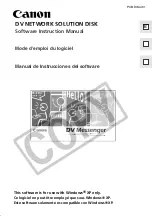
Reducing Meshing Artifacts
189
❚❘❘
subdivision, the minimum mesh spacing was again
too large.
The system renders radiosity solutions by interpo-
lating the color between mesh element vertices. The
color interpolation between the mesh vertex behind
the black panel and the bright mesh vertices outside
the panel caused the shadow leak.
You can alleviate this artifact in several ways, as
described in the following sections.
Model Surface Intersections Explicitly
You can eliminate shadow leaks by modeling the wall
so the intersection between the wall and panel is
explicit. This is worthwhile for explicitly defining the
edges between two surfaces.
Consider the following example showing two ways
to model two intersecting beams.
The sub-optimal technique, shown in the left image,
can result in sample points occurring on the surfaces
of the beams inside the region of their intersection,
possibly leading to shadow leaks. By being explicit
about the surfaces and their intersections, as shown
on the right, you can avoid the shadow leak.
Being as explicit as possible about edges during the
modeling process leads to a better solution in Light-
scape. This does not mean you need to worry about
every point of intersection. For example, you do not
have to model a floor to cut around the legs of a table
nor do you have to cut walls around light switches.
Increase Mesh Elements
One way you can alleviate the shadow leak behind
the panel is to decrease the minimum mesh spacing.
This triggers an adaptive subdivision so that the
edge is properly defined. This approach is illustrated
below. The problem with this approach is that the
system generates a large number of elements to
render a rather insignificant part of the model.
Correct with Ray Tracing
Another approach is to ray trace the light, as shown
in the following example. With this approach you
can keep the sparser mesh. However, this approach
is only valid for single images. Ray tracing light
sources also adds time to the ray tracing process.
Shadow leak caused by an overly large mesh
Left: Sub-optimal
modeling technique for
radiosity processing
Right: Improved modeling
technique for radiosity
processing
Increased number of mesh elements
reduces shadow leak
Ray tracing image eliminates shadow leak
Summary of Contents for LIGHTSCAPE
Page 1: ...SULO 4 31 93 36034333308355 LJKWVFDSH...
Page 18: ...NOTES 10...
Page 110: ...NOTES 102...
Page 136: ...NOTES 128...
Page 166: ...NOTES 158...
Page 176: ...NOTES 168...
Page 202: ...NOTES 194...
Page 210: ...NOTES 202...
Page 248: ...NOTES 240...
Page 294: ...NOTES 286...
Page 308: ...NOTES 300...
Page 316: ...NOTES 308...
Page 324: ...NOTES 316...
Page 342: ...Glossary 334 Lightscape...
Page 360: ...Index ix 352 Lightscape...
Page 362: ......
















































